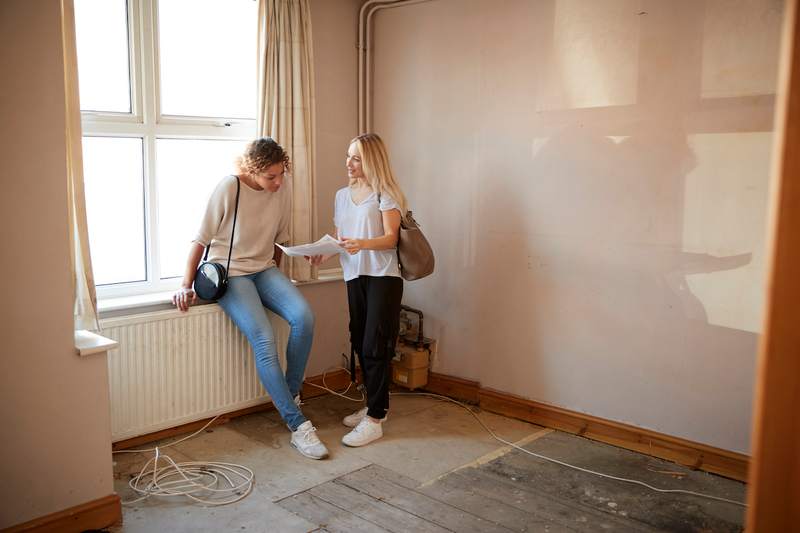When you’re a first-time homebuyer looking through home listings or touring homes, you may come across houses for sale “as is.” It may seem like all homes come as they are, but in real estate, the term “as is” has a specific meaning that’s important for homebuyers to understand.
Key Takeaways:
- Buying a home as is means buying from a seller who won’t make changes or repairs to the property before selling.
- A whole home or just certain parts of it can be sold as is.
- As-is homes are often priced lower than other homes in the area, but may need repairs to be livable.
- Financing an as-is home may be difficult if it’s in very poor shape.
What ‘As Is’ Means
Buying a home as is means the seller won’t make repairs or improvements before closing. It also means the seller won’t provide a seller’s disclosure or credits for potential defects, and is making no guarantees that the home is in good condition.
“Purchasing a home as is simply means the buyer is agreeing to purchase a home, in its current condition, without the seller making any repairs or changes to the property,” says Jason Gelios, a Birmingham, Michigan-based Realtor and author. “The buyer will be responsible for making any repairs needed after closing.”
A seller may list either the entire property or specific aspects of the home as is.
This doesn’t necessarily mean the home is damaged or in poor shape. It only means the seller is making no assurances, and that the buyer will assume responsibility for any problems down the road.
Entire property
Listing the entire property as is means the seller is unwilling to make repairs or improvements to any aspect of the home, and makes no warranties or guarantees that the home is in working order. This can feel risky to many homebuyers, given that there’s no guarantee that the home is ready to move into.
Specific components
Some sellers will list specific components, systems, or parts of their homes as being sold as is.
For example, the seller might say that the fireplace and the garage are being sold as is. This means the seller won’t repair or guarantee anything about those components, but will offer disclosures and may be willing to make other repairs to the home.
Required disclosures
One important thing to note is that selling a home as is doesn’t free the seller from the responsibility of making required disclosures. For example, if a home has lead paint and the seller knows about it, they must disclose that information.
What ‘Where Is’ Means
“Where is” or “as is, where is” is another way of saying the property is being sold in its current condition and that the seller is unwilling to make repairs. It also implies that nothing about the home — such as plants or items on the plot — will be moved, cut, shifted, replaced, or relocated.
3 Reasons Why Homes Are Offered As Is
There are a number of reasons that homes are sold as is.
1. Needs major repairs
The most obvious reason is that the home needs major repairs. Buying the home as is means that the seller doesn’t need to pay for repairs to any components of the property for the sale to go through.
A homeowner who is selling their home while in the middle of a renovation also may list the property as is.
2. Owner won’t pay for minor repairs
Selling as is doesn’t always mean the property is in poor condition or unlivable. It could just mean the seller is unwilling to make or pay for minor repairs, and that potential buyers shouldn’t bother asking for them.
3. Owner needs to sell quickly
A homeowner who needs to sell a property quickly may list their property as is. This can help them attract experienced buyers who understand the real estate market. It also helps avoid delaying the sale with negotiations over whether the seller will make repairs.
What To Consider Before Purchasing a Home As Is
Buying a home as is can mean snagging a great deal on a home that needs a bit of care, or from a homeowner who is motivated to sell. However, it’s important for the buyer to do their due diligence and make sure they know what they’re getting into.
Best practices for buyers
Before purchasing a house as is, buyers should:
- Get a home inspection.
- Ask the seller questions about the home’s condition.
- Do your due diligence on the deed and title of the home.
- Confirm that you are capable of making needed repairs or can afford to hire someone to make them.
Biggest misconceptions of purchasing as is
Many people hear the words “as is” and picture a fixer-upper home that is falling apart at the seams. While some homes being sold as is will be in poor shape, that’s usually not the case.
Some common misconceptions about as-is homes include:
- The home is unlivable. A home sold as is may or may not be in poor shape. You’ll have to see it for yourself to know.
- You can’t get an inspection. Most as-is sellers will let you conduct an inspection. They just won’t pay for repairs.
- No disclosures are required. Sellers don’t have to make assurances about whether certain systems in the home work, but they do need to make legally required disclosures, such as the presence of lead paint.
7 Steps To Take Before Making an Offer
Before you make an offer on an as-is home, take these steps.
1. Work with an experienced agent
Finding an experienced real estate agent is important when you’re looking to buy any home, but it’s even more important if you’re looking to buy an as-is home. An experienced agent can help you examine an as-is home and identify any red flags. You also can rely on them for help in figuring out an offer, and how to negotiate the best deal.
2. Consult a real estate attorney
An attorney can help you understand the legal aspects of your real estate transaction, including your rights and the seller’s obligations. They also can help review the seller’s disclosures for key details.
3. Get a home inspection
Just because a home is sold as is doesn’t mean you can’t get it inspected before closing. A home inspection can give you a more detailed look at the property’s condition.
4. Calculate the repair costs
Get some quotes from contractors so you have an idea of the cost to make essential repairs. If you plan to make repairs yourself, research the cost of materials.
5. Conduct a title search
Order a title search and make sure it’s clean. If there are issues with the title, the seller may not have the right to sell the home.
6. Examine the deed for any red flags
Have your attorney check the deed for easements or liens that could present problems with the property in the future.
7. Consult an insurance agent
Speak to an insurance agent to make sure you can get homeowners insurance on the property. You also might consider a home warranty, which can protect against things like appliance failure.
Financing Considerations for As-Is Homes
Buying a home as is can help buyers get a good deal on a home that may need a bit of work before it’s livable. However, financing can complicate the purchase. Mortgage lenders want to make sure that the home is worth enough to secure a mortgage before offering a loan.
Part of ensuring that a home is worth enough to secure a loan is making sure it’s in good shape and livable condition. Different types of mortgages will have different eligibility requirements for properties. Some loan programs might let you buy a property with minor problems, or noteworthy but fixable issues — such as lead paint — while others will not.
Conventional loans
A conventional loan conforms to federal requirements that allow your lender to sell it to Fannie Mae or Freddie Mac. In addition to financial requirements, Fannie and Freddie set requirements for the condition of the property.
Minor issues — like worn carpet or flooring, torn window screens, missing handrails, or damaged sidewalks — won’t scuttle a deal. Major problems, like structural damage that could render the home unsafe, will make it impossible to get a loan until those problems are fixed.
FHA loans
For Federal Housing Administration loans, the requirements are similar to those for conventional loans: The home must be in safe and livable condition. This means homes that need major renovations to be livable won’t qualify for an FHA loan.
The Department of Housing and Urban Development publishes minimum property standards so you can review what may cause a house to be ineligible.
VA loans
Given that they’re sponsored and insured by the government, Veterans Affairs loans have stricter requirements than other types of mortgages. In addition to structural and safety standards, VA loans require the roof to be in good condition, and that the home is free of pests and lead-based paint. These requirements can make it difficult to get a VA loan for as-is properties.
USDA loans
Department of Agriculture loans help low- and middle-income borrowers buy homes in rural areas. They require that the home be safe and livable. For example, the home needs to be structurally sound and have water and plumbing access, functional doors and windows, and working utilities.
Additional Protections for As-Is Homes
When buying an as-is home, you need to perform due diligence to ensure that you’re aware of any issues with the home and any repairs that will be necessary. However, even with the closest of looks at a property, you might miss something.
Home warranties
If you’re thinking about buying an as-is home that doesn’t need a bottom-to-top overhaul, you might consider a home warranty policy.
A home warranty is an insurance policy that covers the cost to repair or replace defective major appliances and systems in your home. For example, if the oven stops working or the air conditioner breaks down, a home warranty will help pay for the cost of repairs or a replacement.
Home warranty costs vary widely. You can expect to pay anywhere from $300 to $1,000 or more for an annual policy.
Getting a home warranty on an as-is home might be tricky, given that the company will be hesitant to insure a system that’s in questionable condition. However, if the home is in good shape overall, you may be able to get a warranty on it.
Read the fine print of a home warranty, consider its cost, and think about how much money you’ll save if something does go wrong with the home.
Should You Buy an As-Is Home?
Buying a home as is can save you money upfront, but there are some pitfalls to watch out for.
“One advantage of buying as-is is the potential for obtaining a property at a lower price, as sellers often factor in the cost of necessary repairs or renovations,” says Brett Johnson, a Denver-based real estate investor. “However, it’s essential to carefully weigh the cons as well. As-is homes may have hidden issues or require significant repairs, which can add unforeseen expenses and challenges to the buyer.”
Pros of buying an as-is home
Some of the advantages of buying a home as is include:
- Lower price. As-is homes usually cost less than move-in ready homes in the same area because they need repairs, or the seller is motivated to sell.
- Fast closing. If the seller wants to sell fast, you can close the sale more quickly.
- Less competition. Many buyers avoid as-is homes because they want something that is move-in ready — meaning you can avoid a bidding war.
Cons of buying an as-is home
Before buying an as-is home, consider these drawbacks:
- Hidden problems. Even with an inspection and a careful eye, you might later learn the home has significant and expensive problems that you’ll have to pay to repair.
- Difficult financing. Many lenders are more hesitant to finance as-is homes that are in poor condition. Some government loan programs have property requirements that will make it difficult to qualify for a loan to buy such homes.
- Limited negotiating power. As-is sellers are often inflexible. They are selling the home exactly the way it is and won’t make any changes, so you don’t have much room for negotiating a favorable deal.
As-Is Homes FAQ
Here are answers to some frequently asked questions about buying a home as is.
Yes. However, financing for an as-is home is often more difficult to get than it is for a turnkey home, especially when it comes to government-backed loans.
Yes. An inspection will detail the home’s overall condition and let you know what you’re buying, even if the seller is unwilling to make repairs.
When buying a home as is, some major red flags to look out for include:
— Cracked or damaged foundation.
— Roof damage.
— Mold.
— Septic system failure.
— Water-stained or sagging ceilings.
These can all be signs of major problems that could be very expensive to repair.
The Bottom Line on Buying a Home As Is
Buying an as-is home can be a great way to get a good deal on a house, so long as you’re willing to do a bit of work yourself or hire help to get the home into good condition. Watch out for red flags, and make sure to perform your due diligence when considering buying one of these homes.






